Why and How Were the Terracotta Warriors Made?
First Emperor Qin (/chin/), from whom China gets its name, ordered the creation of this army of terracotta statues.
6 Steps to Make a Terracotta Warrior
You will find that some terracotta figures are without heads, but their bodies are complete. Studies of their portions have revealed that the heads, arms, and torsos of the figures were created separately and then assembled.
It is believed that most warriors' heads and arms were produced in molds as separate modules. After assembly, clay was applied to the surface of the sculptures so that artists could model the faces and hairdos individually.
Then, the figures were fired in kilns to make the clay hard and durable. Afterwards, they were painted with bright colors.
As a result, every figure looks different and unique, just like real people do. After 2,000 years of erosion and humidity, most figures have lost their original vivid color.
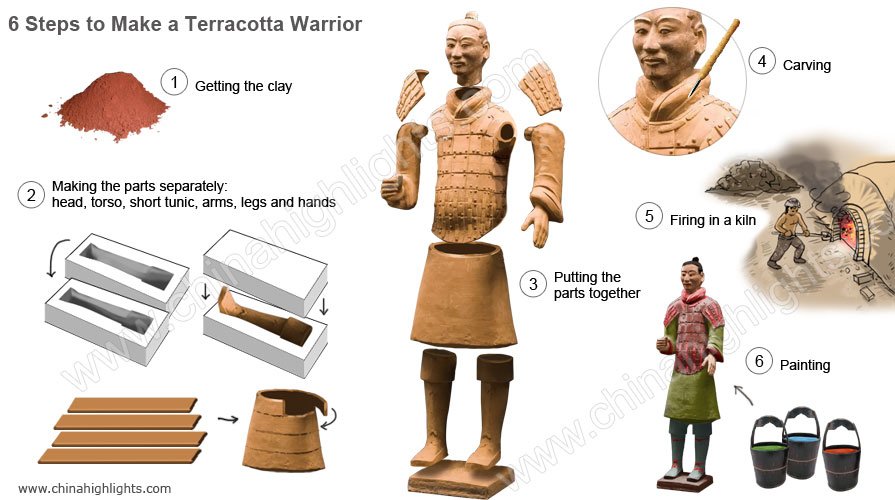
How They Were Discovered
The Terracotta Army figures' excavation is regarded as one of the greatest discoveries of the 20th century. It had lain underground for more than 2000 years before farmers digging a well in 1974 uncovered what is now considered one of the greatest archaeological sites in the world.
The first part of the Terracotta Army site to be discovered was named Vault One. In 1976, two other vaults were uncovered about 20 meters away, and were named Vault Two and Vault Three.
The tomb is a treasury for the Chinese people and for the whole world. In December 1987, UNESCO selected the Tomb of the First Emperor (including the Terracotta Army Vaults) as a World Cultural Heritage Site.
The History of the Terracotta Army
See the Terracotta Warriors in Detail — Categories, Distinctive Features, and Weaponry
Three Major Categories
In the three pits, approximately 8,000 life-size, vivid in battle formation were revealed in the course of excavation — a whole army, which would accompany its emperor into immortality.
The excavated terracotta figures fall into three major categories: infantry, cavalry, and charioteers.
The infantry can be further divided into subcategories, including officers of high, middle, and low rank, light-armed and heavy-armed foot soldiers, and standing and kneeling archers.
The charioteers can be further divided into two subcategories: chariot drivers and chariot warriors.
Distinctive Features: Facial Shapes, Hairstyles, and Dressing
Every figure differs in its facial features and expression, clothing, and hairstyle in accordance with its rank.
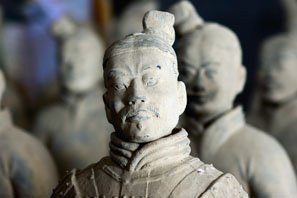 A figure with a '目'-shaped face
A figure with a '目'-shaped faceFacial Shapes
Analyses show that the facial shapes of the terracotta figures can be roughly classified into eight types, and each shape resembles a Chinese character: 目, 国, 用, 甲, 田, 由, 申, and 风. For example, '目'-shaped faces look relatively narrow and long, and have small features.
Hairstyles
Hairstyles in ancient times were not only part of people's lifestyles but also a reflection of their social status. The hairstyles of the terracotta warriors are different based on their ranks and arm of the services.
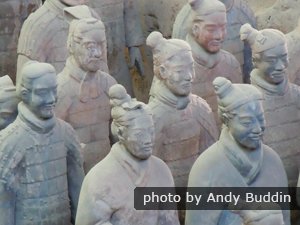 The different hairstyles of the Terracotta Warriors
The different hairstyles of the Terracotta WarriorsThe hairstyles of the figures can be roughly divided into two types. The first type includes figures wearing their hair in a bun on the right side of the head. The other type depicts figures wearing their hair in a plait and forming a bun at the top of the head that was then covered with a cloth cap.
Bands, ribbons, or pins were used for typing up their hair.
Dressing
The clothing of the terracotta figures is different. You can tell the rank and arm of military service of each figure from its dressing. Let us take some figures as examples:
The general wears two layers of robes beneath an armored tunic that protects his chest, back, and shoulders. He wears square-toed shoes, which are lightweight and curve upwards at the front. Only one general was found in Pit 1 and two in Pit 2.
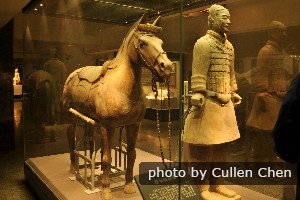 A cavalryman
A cavalrymanArmored warriors wear robes covered by turtleneck, heavily armored capes designed to protect their chests, backs, and shoulders.
Cavalrymen wear pillbox hats, neck scarves, and light body armor to the front and back. Their shoes are soft and round at the toes so as not to injure their mounts.
Chariot drivers have extra protection for their outstretched arms and hands that need to control the horses' reigns. They wear helmets to protect the
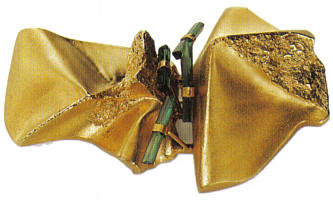
No comments:
Post a Comment